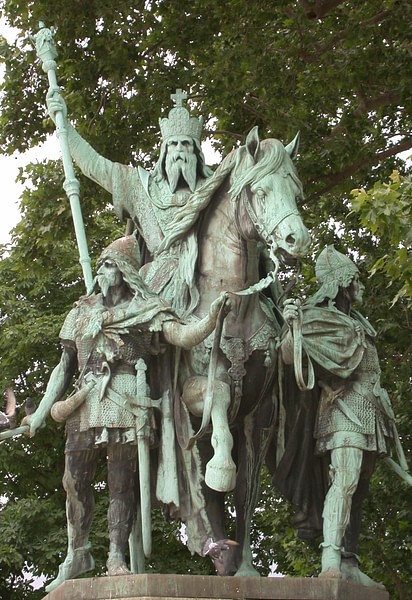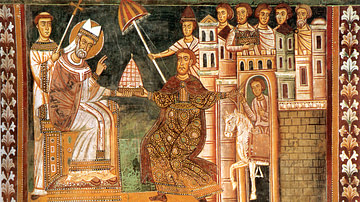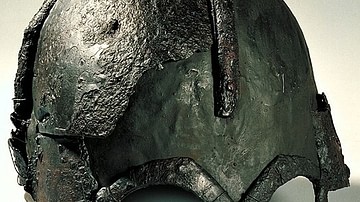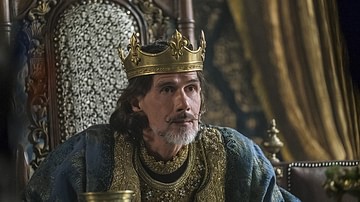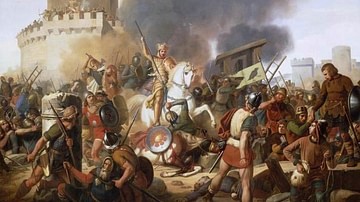
Charlemagne (Charles the Great, also known as Charles I, l. 742-814) was King of the Franks (r. 768-814), King of the Franks and Lombards (r. 774-814), and Holy Roman Emperor (r. 800-814). He is among the best-known and most influential figures of the Early Middle Ages for his military successes which united most of Western Europe, his educational and ecclesiastical reforms, and his policies which laid the foundation for the development of later European nations.
He was the son of Pepin the Short, King of the Franks (r. 751-768, first king of the Carolingian Dynasty). Charlemagne ascended to the throne at his father's death, co-ruling with his brother Carloman I (r. 768-771) until the latter's death. As sole ruler afterwards, Charlemagne rapidly expanded his kingdom, styled himself the head of the Western Church – superseding the popes of the time in power – and personally led military campaigns to Christianize Europe and subdue unrest almost continuously for the 46 years of his reign.
His death in 814 of natural causes was considered a tragedy by his contemporaries, and he was mourned throughout Europe; more so after the Viking raids began shortly after he died. He is often referred to as the Father of Modern Europe.
Early Life & Rise to Power
Charlemagne was born, probably at Aachen (in modern-day Germany) during the final years of the Merovingian Dynasty, which had ruled the region since c. 450. The Merovingian king had been steadily losing power and influence for years while the supposedly subordinate royal position of Mayor of the Palace (equivalent to a Prime Minister) had grown more powerful. By the time of King Childeric III (r. 743-751), the monarch had virtually no power and all administrative policies were being decided by Pepin the Short, Mayor of the Palace.
Pepin understood that he could not simply usurp the throne and expect to be recognized as a legitimate king and so he appealed to the papacy, asking, “Is it right that a powerless ruler should continue to bear the title of King?” (Hollister, 108). The papacy at this time was dealing with a number of problems ranging from the hostile Lombards in Northern Italy to the iconoclasm controversy with the Byzantine Empire.
The Byzantine Emperor had recently condemned any representation of Christ in churches as idolatry and ordered them removed. Further, he had tried to dictate this same policy to the pope and have it followed in Western Europe. As the scholar C. Warren Hollister phrases it, "the papacy had never been in such desperate need of a champion" when Pope Zachary (served 741-752) received Pepin's letter. He more or less instantly agreed with Pepin.
Pepin was crowned King of the Franks in 751 and, in keeping with royal precedent, named his two sons as his successors. Among his earliest acts as king, Pepin defeated the Lombards and donated a significant amount of their land to the papacy (a grant known as the "Donation of Pepin"). The papacy, for their part, hoped to control Pepin and his successors and claimed authority over the Frankish crown by virtue of a document known as the Donation of Constantine, allegedly drawn up by the first Christian Roman emperor Constantine I himself, stating that a Christian monarch gave his rule up voluntarily to the papacy and the pope then graciously handed it back.
According to the document, the Church was actually the power behind every throne and could take that power as easily as it had been given. The document was a forgery – and there is no evidence that Constantine ever made any such statement in any way – but there was no way Pepin could have known that and, being illiterate, he had little choice but to believe whatever the clergy told him was on the paper they waved in front of his face. Pepin accepted the stipulation of the Donation of Constantine; his son would not.
King Pepin died in 768 and his sons ascended to the throne. Co-rule with Carloman was far from harmonious as Charlemagne favored direct action in dealing with difficulties while his brother seems to have been less decisive. The first test of their rule was the rebellion of the province of Aquitaine, which Pepin had subdued, in 769. Charlemagne favored a military campaign, which Carloman did not support.
Charlemagne marched on Aquitaine and defeated the rebels, also subduing neighboring Gascony, while Carloman refused to participate in any of it. In 770, Charlemagne married and then repudiated a Lombard princess, daughter of the king Desiderius (r. 756-774) to marry the teenage Hildegard (future mother of Louis the Pious, r. 814-840). Following overtures by Desiderius to Carloman to topple Charlemagne and avenge his daughter's honor, the two brothers were on a direct course to civil war when Carloman died in 771.
Military Campaigns & Expansion
As sole ruler of the Franks, Charlemagne ruled from the start by force of his personality which embodied the warrior-king ethos combined with Christian vision. Hollister describes the king:
Charlemagne towered over his contemporaries both figuratively and literally. He was 6 ft. 3 ½ in. tall, thick-necked, and pot bellied yet imposing in appearance for all that. He could be warm and talkative, but he could also be hard, cruel, and violent, and his subjects came to regard him with both admiration and fear…Above all else, Charlemagne was a warrior-king. He led his armies on yearly campaigns as a matter of course. Only gradually did he develop a notion of Christian mission and a program of unifying and systematically expanding the Christian West. (109)
After building up his army, he launched his first campaign into Saxony in 772, beginning a long and bloody conflict known as the Saxon Wars (772-804) in an effort to root out Norse paganism in the region and establish his authority there. Leaving troops in Saxony, he turned to Italy where the Lombards were asserting themselves again. He conquered the Lombards in 774 and brought their lands into his kingdom, thereafter calling himself "King of the Franks and Lombards", and then turned back to Saxony.
Basque unrest in the Pyrenes drew Charlemagne and his army in that direction for a number of engagements including the famous Battle of Roncevaux Pass in 778 (the inspiration for the later epic poem The Song of Roland) in which Charlemagne's rearguard was ambushed and massacred, including the count Roland of the Breton March. This defeat did nothing but further Charlemagne's resolve to bring the region completely under his control.
Between 778 and 796, Charlemagne campaigned every year in the Pyrenes, Spain, and Germania winning repeated victories. In 795, he accepted the surrender of the Avars of Hungary but, refusing to trust them, attacked their stronghold (known as The Ring) and defeated them completely in 796, effectively ending them as a people. He had also defeated the Saracens of northern Spain, establishing a buffer zone called the Spanish March, and taken the island of Corsica. His kingdom now extended through the region of modern-day France, northern Spain, northern Italy, and modern-day Germany except for Saxony in the north.
Saxon Wars
Each time Charlemagne thought he had subdued the Saxons and put their struggle to rest, they rebelled again. Prior to the Saxon Wars, the region of Saxony had been on good terms with Francia and regularly interacted with them, serving as a trade conduit to Scandinavian countries. In 772, a Saxon party was said to have raided and burned a church in Deventer (in the modern-day Netherlands, then part of Charlemagne's kingdom) and this gave Charlemagne his excuse to invade the region. Why the Saxons would have burned the Deventer church, and even whether they really did, is unknown. Knowing Charlemagne's intolerance for pagan beliefs and practices, it is likely the Christian king was behind the church's destruction to justify an invasion of the Germanic tribe he would have undertaken anyway.
In retribution for the burned church, Charlemagne marched on Westphalia and destroyed the Irminsul, the sacred tree representing Yggdrasil (the Tree of Life in Norse mythology), and slaughtered a number of Saxons on his first campaign. His second, third, and the rest (totaling 18) followed the same model of destruction and massacre. In 777 a Saxon warrior-chief named Widukind led the resistance and, although an able leader, he was as helpless to seriously challenge Charlemagne's war machine as anyone else in Europe had been. He did, however, negotiate with King Sigfried of Denmark to allow Saxon refugees into his kingdom.
In 782, Charlemagne ordered the execution of 4,500 Saxons in an atrocity known as the Massacre of Verden to break the Saxon's will to fight, but they still would not surrender their autonomy or repudiate their religion. Widukind offered himself for baptism soon after (either in 784 or 785) in a gesture of peace and it is recorded that he was baptized but then disappears from the historical record soon after.
Charlemagne put an end to the refugee train to Denmark in 798, and the Saxon rebellions continued after Widukind's disappearance. Charlemagne responded as he had for the past 30 years, with the same results. Finally, in 804, Charlemagne deported over 10,000 Saxons to Neustria in his kingdom and replaced them in Saxony with his own people, effectively winning the conflict but earning the enmity of the Scandinavian kings, particularly Sigfried who attacked the Frankish region of Frisia shortly afterwards. This conflict could have become another prolonged event but Sigfried died and his successor sued for peace.
Holy Roman Emperor
Throughout the Saxon Wars and his other campaigns, Charlemagne was acting entirely on his own initiative and paying very little attention to the papacy. None of the popes were complaining, however, because Charlemagne's various enterprises coincided with their own interests or benefited them directly. It was clear by 800, however, that Charlemagne's power exceeded that of the papacy and there was nothing anyone could do about it.
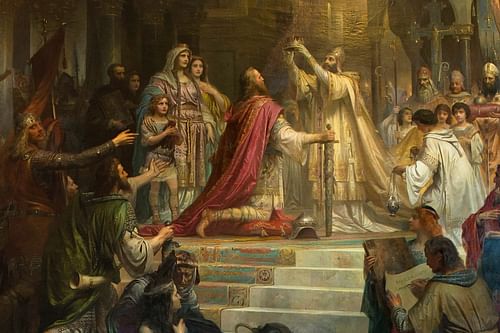
On December 23, at a trial at which Charlemagne presided, Leo finally purged himself of the accusations against him. This course of events had signified a dreadful humiliation for the pope and his abnegation before the Carolingian ruler and he determined to try to regain the prestige and authority of his office by carrying out the imperial coronation of Charlemagne. On Christmas day, 800, as Charlemagne rose from prayer before the tomb of St. Peter, Pope Leo suddenly placed the crown on the king's head and the well-rehearsed Roman clergy and people shouted, “Charles Augustus, crowned great and peace-giving emperor of the Romans, life and victory!” (181)
Charlemagne allegedly did not want to be crowned by Leo and reportedly said he would never have entered the church if he had known it would happen. However that may be, it is well-established that the crown was clearly visible in the church when Charlemagne entered and the man was certainly intelligent enough to realize it had not been left there accidentally. Most likely, Charlemagne welcomed the prestige of the title but was not about to allow the papacy an upper hand to wield their Donation of Constantine pseudo-leverage over him.
Ecclesiastical & Educational Reforms
There seems little doubt that the coronation was an attempt by the papacy at establishing some measure of control over Charlemagne. Hollister notes how "the popes believed that the emperors ought to be papal stewards – wielding their secular political authority in the interests of the Roman Church" (112). Even so, there was no practical need to do this as Charlemagne had been consistently combining his own interests with those of the Church since he came to power.
Aside from his regular military victories, Charlemagne had also engaged in ecclesiastical and educational reform, improving the function of churches, monasteries, and educational institutions throughout his kingdom – now his empire. Technological advances during the Merovingian Dynasty and the reign of Pepin the Short had already provided a foundation for greater prosperity. Agricultural advances – such as crop rotation between three fields, the invention and use of the compound plow which replaced the earlier scratch plow, and encouraging peasants to pool their resources and labor in farming – all led to increased food production and better care of the land. Charlemagne improved on the improvements by encouraging further development of mechanization such as the water mill for grinding grain instead of the previous method of grinding by human labor.
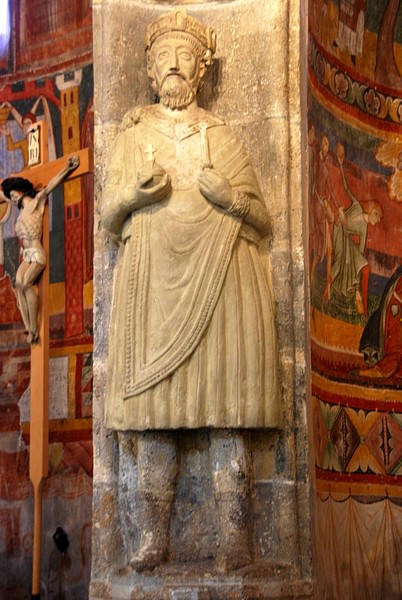
Pepin the Short had initiated a reform of the Frankish Church spearheaded by St. Boniface (l. 672-754) who established order in religious houses and developed monastic schools. He also divided regions into parishes for easier administration. Charlemagne capitalized on these advances by furthering their development and surrounding himself with the brightest minds of his era, such as the scholar Alcuin of York who emphasized literacy as an important aspect of piety. This policy was advanced in the monastic schools throughout Charlemagne's empire, improving literacy rates and producing better students. The earlier reforms of Boniface were continued as Charlemagne sent out commissioners from his capital at Aachen to the various districts and parishes to make sure his decrees were being implemented properly and that all aspects of his administration were functioning toward a single goal. However, it seems there was no real reason for these commissioners as those whom Charlemagne trusted with positions of authority performed their duties out of personal loyalty to him, not to the state.
Legacy
Charlemagne ruled his empire for 14 years until his death from natural causes in 814. Loyn notes how his "force and dynamic personality were needed to create the empire and, without him, disintegrating elements quickly gained the ascendancy" (79). He had already crowned Louis the Pious as successor in 813 but he could do nothing to ensure his legacy would endure after he died. Cantor comments:
The death of only a few enlightened leaders, or even the sudden loss of one great personality, can cause the whole system to collapse and open the way for an equally rapid reversion to chaos and barbarism. Surrounding the enlightened group of leaders in such a preindustrial society are a mass of wild warriors and bovine peasants who lack any comprehension of what the leaders are trying to do. Consequently, as the central direction falters, there is an immediate backsliding into barbarism. (172)
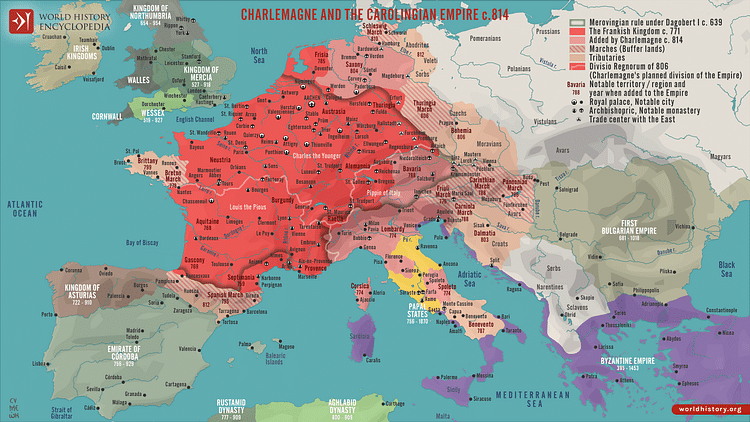
The initial troubles for the empire, however, were due not to any backsliding or disintegrating elements but to Charlemagne's own choices regarding Saxony decades earlier. The Saxon Wars destroyed the region, killed thousands of people, and did little else except enrage the Scandinavian kings who bided their time until Charlemagne's death and then unleashed the Viking raids on Francia. During Louis' reign, between 820 and 840, the Vikings struck repeatedly at Francia. Louis did his best to fend off these attacks but found it easier to appease the Norse through land grants and negotiations.
When Louis died in 840, the empire was divided among his three sons who fought each other for supremacy. Their conflict was concluded by the Treaty of Verdun of 843 which divided the empire between Louis I's sons. Louis the German (r. 843-876) received East Francia, Lothair (r. 843-855) took Middle Francia, and Charles the Bald (r. 843-877) would rule West Francia. None of these Frankish kings were interested in helping the others, and the empire's infrastructure, as well as most of the reforms advanced by Charlemagne, deteriorated. The Viking raids continued from 843 to c. 911 when they were finally ended by Charles the Simple (r. 893-923) through a treaty with the Viking chieftain Rollo (later Rollo of Normandy, r. 911-927).
Although Charlemagne himself was never affected by the church's absurd Donation of Constantine fraud, his descendants were not as strong, and the later Carolingian Dynasty would suffer accordingly as the popes asserted their supposed political authority. The separate kingdoms of Charlemagne's empire would eventually form the modern nations of Europe and, for all his faults, could not have done so if not for his vision of purpose and natural abilities to lead in such a way that others were eager to serve him.

